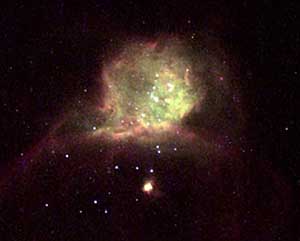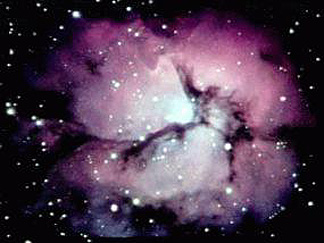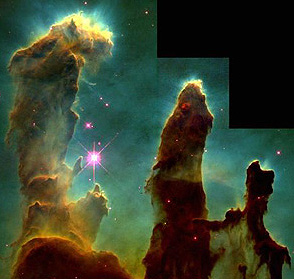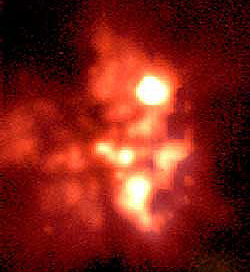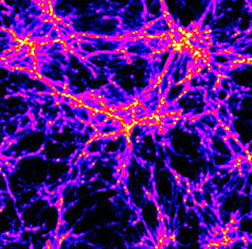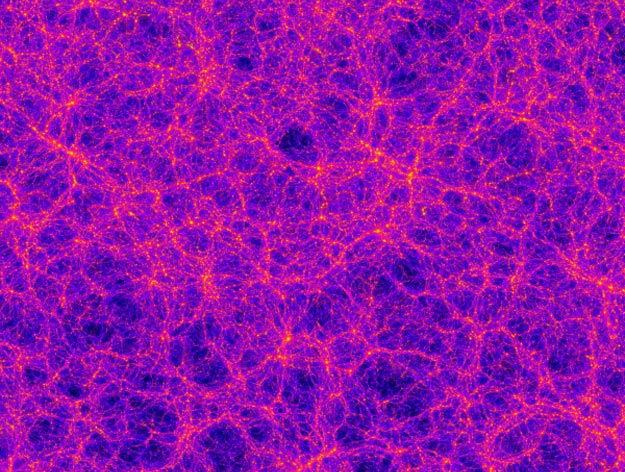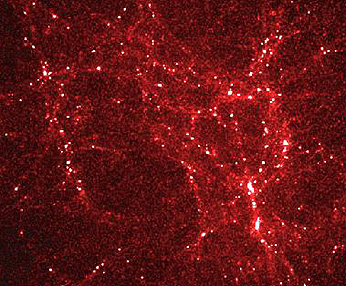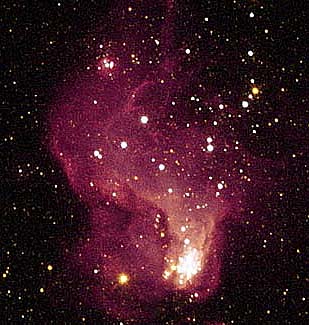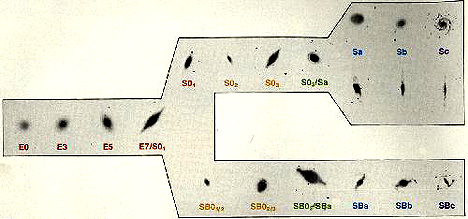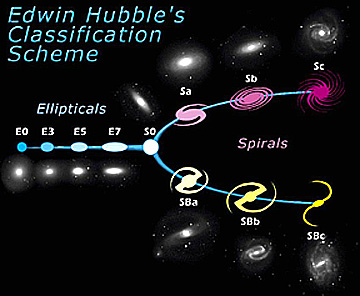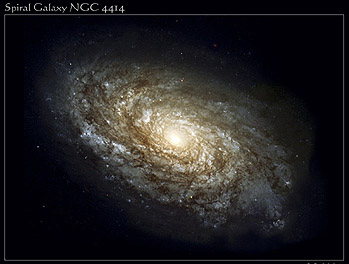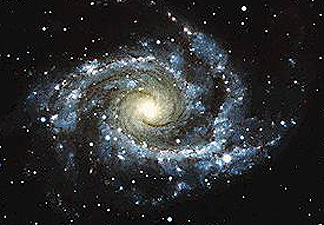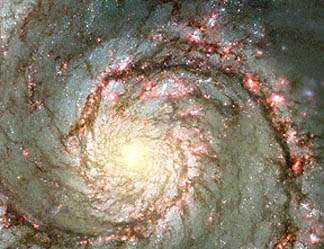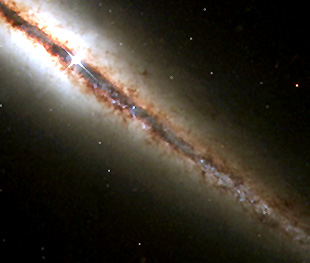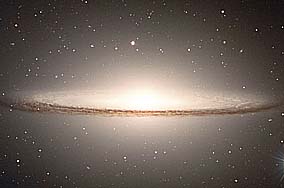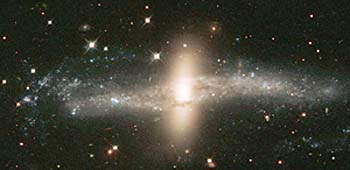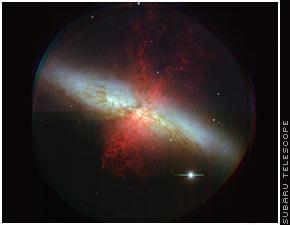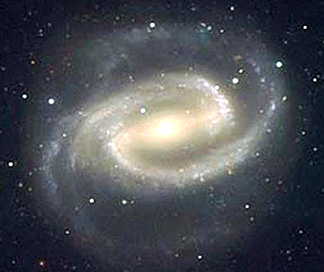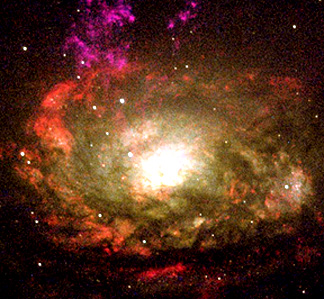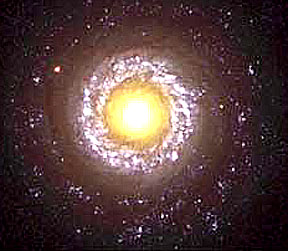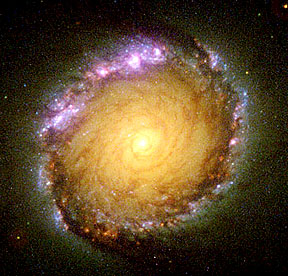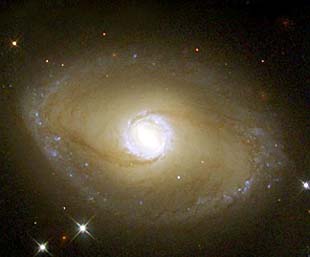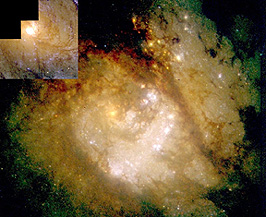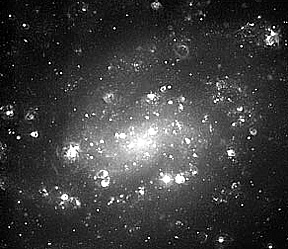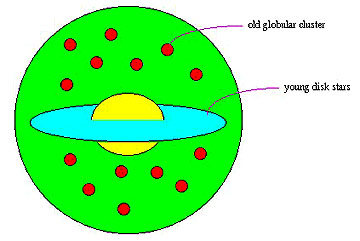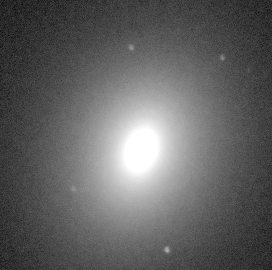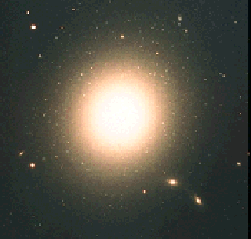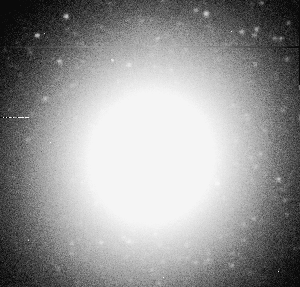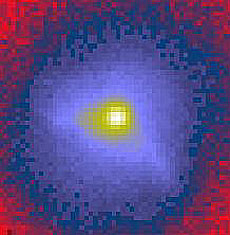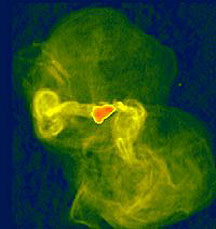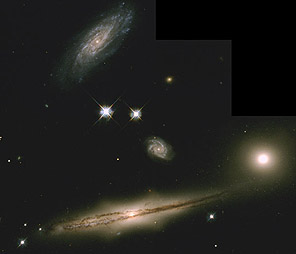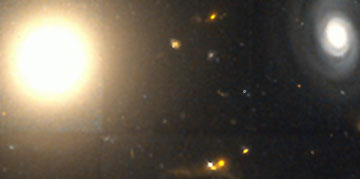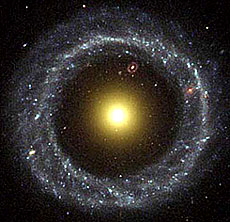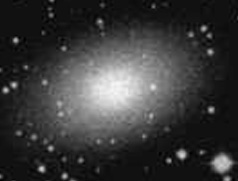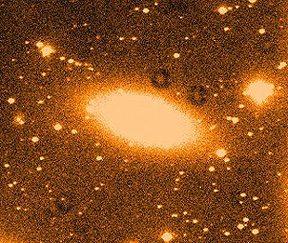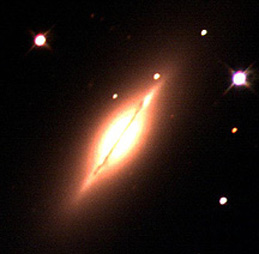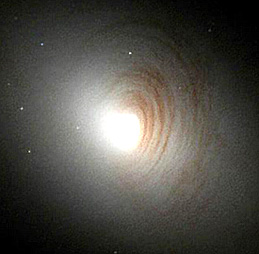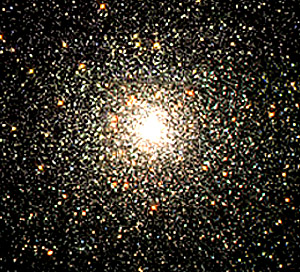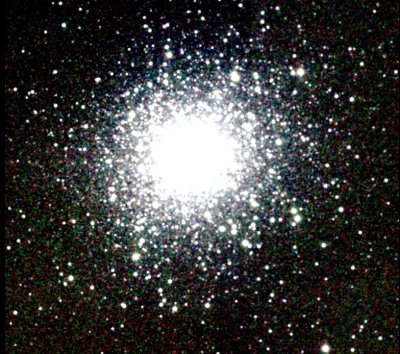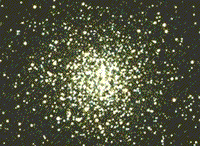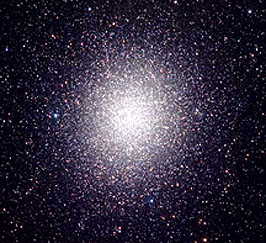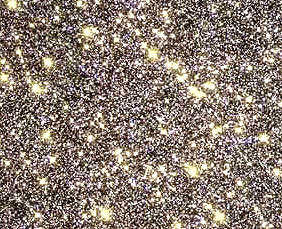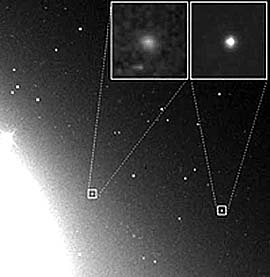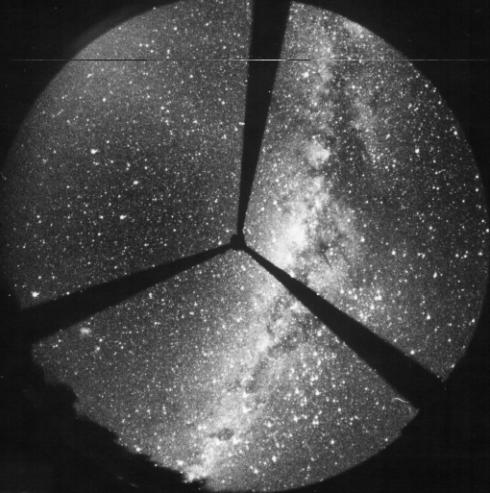
But as the Big Bang concept took hold, it was realized that expansion rates would carry distant "stars" well beyond the M.W.'s sphere of influence. In the late 1920s, Edwin Hubble was the first to present strong evidence that these stars were actually other galaxies. Thus the Universe became much bigger and contains a myriad (billions) of galaxies that make up the visible entities filling expanding space.
A galaxy is an organized
concentration or clumping of stars held together by mutual gravitational interaction
in an aggregate containing billions of discrete individual stellar objects organized
into varying shapes/structures. Typical maximum dimensions of a galaxy range from
80,000 to 150,000 light years in space-time diameter. The central disk of the
most photogenic type - the Spiral Galaxy - is about 10000 light years in thickness.
Galaxies contain huge numbers of individual stars - a common number cited is 100
billion stars, but some have less and a few up to a trillion. At least 10 billion
galaxies have developed in the observable Universe. (Of course, these numbers
are estimates made by sampling regions of space close to us; attempts to accurately
inventory all galaxies and stars by some counting approach are currently
not feasible, and would suffer from incompleteness owing to the probable existence
of stars/galaxies beyond observable limits.)
While the question is not
fully settled as to whether stars must have formed before the first galaxies,
there is a growing consensus that a group of very massive, gradually heated
stars emerged before any galaxies. These stars, composed almost entirely of
hydrogen and helium, organized rapidly, burned for a short time (around 3 million
years), underwent collapse and exploded as supernovae. Being the first "furnaces"to
produce heavier (atomic weight) elements, the destroyed stars yielded materials
(including carbon, calcium and oxygen) that became incorporated in the first
galaxies to form. This topic - the first stars - is treated in more detail on
page 20-5. (NOTE: Many
Cosmology texts and overviews start with a discussion of stars before galaxies;
in this Tutorial that is reversed, as we favor treating these larger structures
as seen at different wavelengths throughout the EM spectrum prior to a detailed
analysis of how stars - the principal members of galaxies - is undertaken.)
A quick synopsis (preview)
of galaxy formation: As the dispersing mix of primordial H and He (He comprises
about 10% of the various atomic species present) atoms, photons, and other particles
continued to expand (thereby progressively decreasing in density), it eventually
cooled to temperatures around a few degrees Kelvin (see Cosmic Background Radiation
on page 20-9). Large-scale
variations (called fluctuations or seed perturbations) in mass and energy density,
whose origin can be traced to the early moments of the Big Bang, occurred at random
throughout the enlarging Universe. These regions where the density was greater
eventually grew (as described below) into protogalaxies and then galaxies.
As early as the first 100
million years (m.y.) (cosmic time; measured from the moment of the Big Bang) and
perhaps as far back as just after the Decoupling Era, but especially in the first
1 to 2 billion years, protogalaxies (incipient or first stage assemblages of the
hydrogen-rich gas that evolve into galaxies) began by means of gravitational
attraction to develop as denser regions throughout the expanding Universe. This
process was guided by gravity-driven irregularities or ripples in the almost
homogeneous distribution of particles in the early stage expansion of the Universe.
These denser strands or pockets of matter evolved over time as stars formed and
collected into fullblown galaxies, with most now observed having formed during
the first four billion years. The principal hallmark of galaxies is that they
consist of stars (whose nature and development are described on page 20-5). Stars are individual
spherical clots of gas (initially H and some He) that form by further gravitational
collapses within broader irregularities of greater concentrations of gas and some
dust forming "clouds" (also called nebula but this latter term usually refers
to gas/dust concentrations within a larger cloud, within existing galaxies, or
gaseous debris from supernova explosions); as this densification increases, the
gases contract and heat up to interior temperatures reaching > 106
°K, sufficient to initiate nuclear reactions (the conversion of H to He) so that
the stars become luminous (radiant) bodies.
Amazingly, despite the vast
number of stars in a galaxy, most of the Universe's space is nearly empty of luminous
matter, making up intragalactic and, even more so, intergalactic open regions.
Likewise, individual stars in a galaxy are widely separated (a scale analogy:
if a star is represented by a marble just 1 centimeter in diameter, the average
distance to its nearest neighbor stars is around 300 kilometers [~200 miles]).
All stars together (totaled for all galaxies) comprise just about 1 part per million
by size within the space dimensions calculated for the known Universe: thus in
the total volume of observable space, "void" dominates and luminous objects are
an exceedingly small part (far less than one might expect by looking through a
telescope in which much of the field of view seems occupied by points of light
[galaxies or galactic clusters], since there are huge distances between them in
the direction of viewing).
While most galaxies are very
old, some are younger and a small fraction may even have started forming in the
last few hundred million years. One example (below) of an embryonic galaxy is
Hubble-X , in the constellation Sagittarius (NGC6822), which is about 1.6 billion
light years from Earth. Evidence based on star characteristics indicates the cloud
started producing stars only about 4 million years ago, but a well-defined galactic
shape is yet to emerge.
However, in general within
galaxies the majority of larger stars has since expired (by supernova explosions,
etc.) even as new stars (including those of masses up to 100 times that of the
Sun) continually form (some recently, in Universe time) from the debris and gases
remaining in the intragalactic materials that persist throughout the history of
the galaxy. Other materials are drawn in as encountered during a galaxy's travels
in space.
The starting point of galaxy
formation requires accumulation of hydrogen-rich gas, with some helium, in a great
cloud (many millions of light years in dimension). This stellar nursery is also
called a "Giant Molecular Cloud" because much of its hydrogen is combined as H2.
For this accumulation to happen there must initially be localized regions of the
expanding universe whose density is slightly greater than the generally uniform
distribution of matter and photons that, most cosmologists believe, was the outcome
of the processes operating during the earliest stages of big bang expansion. Studies
of cosmic background radiation (see page
20-9) indicate these density disparities may have been as small as 1 part
in one hundred thousand. The slight differences in density also give rise to slightly
greater gravitational forces which act to draw material towards these local perturbations.
As more matter accrues within
a growing cloud, its internal gravity continues to increase and draw in still
more gases. The molecular cloud eventually reaches a density that requires it
to then undergo local clumping of gases into clots that grow into still denser
concentrations to become stars (these smaller clots can exist for much of the
galaxy's life but are the sites of further star formation).
The next HST image shows
huge clots of gas and dust in a more advanced stage of development in which
stars will eventually form en masse as part of a spiral or globular galaxy
(see below):
Many star-forming clouds
are very rich in dust, in addition to the hydrogen gas, which make them appear
as discrete dark clouds. As we shall see on page 20-7, these clouds contain
various amounts of heavier elements (but still only a tiny fraction of the hydrogen
and helium species) produced within the first stars and dispersed when these
exploded as supernovae. A prime example of vast dust cloud "nurseries" from
which stars are born is shown in this next image, now near the top of the list
of most "spectacular" of HST images captured so far. The great protuberance
of dust-gas is called the Horsehead (from its shape) Pillar (left) making up
the Eagle Nebula. (See page
20-11 for three more views of this nebula) That these clouds are thermally
active, especially where the clots are organizing into protostars, is evident
in this ratio image made from thermal bands, as follows - 20µm/10µm - in this
view of a cloud near the center of the Orion galaxy, made using the TIMMI2 (second
Thermal IR MultiMode Instrument) on the 3.5 m telescope operated by the European
Southern Observatory:
One model ("top down") of
early galaxy evolution considers a cloud to fragment into star groupings as it
develops from hot dark (radiating but not luminous) gaseous matter. Another galactic
model ("bottom up") begins the process with localized multi-star formation from
cold dark (low levels of EM radiance) matter, with subsequent aggregation into
fewer stars that grow mainly by collision (sometimes described as "cannibalism")
with one another. Recent observations suggest the bottom up model describes the
predominant process.
In the first billion years
or so of the Universe, as galaxies organized, models for their spatial distribution
may have looked something like this computer-generated simulation of filaments
within which gases of varying density (high = yellow; lower = blue) lead to organization
into individual or clusters (see below) of galaxies. :
A similated model, highlighting
filaments of hydrogen gas, shows a similar pattern. This is from the work done
by Prof. James Wadsley of McMaster University in Canada:
That such filaments actually
existed is suggested by this HST view of a very old network of filamentous galaxies
and stars in deep space.
A possible analog to this
early stage of galactic development, with gas clouds producing a plethora of
stars, is this star burst found in galaxy NGC6832:
Thus, star formation is a
general process (see page 20-5)
that can take place wherever widespread-to-local concentrations of dominantly
hydrogen gas produce clouds of matter of sufficient density to initiate gravitational
contractions. Typically, only a few percent of a cloud's mass will be organized
into stars.
There are four general
types of galaxies, classified by their geometric shapes (morphologies) and distributions
of the stars that comprise them. These are 1) Spirals (the most common), 2)
Ellipticals, 3) Dwarfs, and 4) Irregular. The major forms are indicated, with
their symbols, in this diagram (the Dwarfs and the Irregular or Peculiar groups
are not included but are discussed below). The arrows denote a progression of
variation but do not necessarily connote evolution of one form to the next (true
in some cases). In Hubble's time, opinion favored a left to right evolutionary
trend, i.e, ellipticals may (but do not necessarily) morph into spirals. Today,
whatever changes occur are from right to left. As mentioned on this page, one
process involves collision of two spirals that removes the arms, builds up the
central core, and leads to an elliptical. For further clarity, this
second version of the classification should be looked at:
This HST image shows a well-organized
spiral galaxy (NGC4414; NGC refers to New General Catalog, one of several systematic
listings of stars and galaxies observed through telescopes) in which much gas
and dust still remains:
Spiral galaxies,
which seem at present to be the dominant type, consist of stars arranged in
a flattened disc wherein younger (blue) stars are strung out in several prominent
spiraling arms that emanate from a central nucleus or bulge that is comprised
of a denser collection of older (yellow to orange) stars. Compared to the entire
Universe - with both galactic and intergalactic components filling the space
- this central core is about 100 billion times the density of the Universe as
a whole (this also applies to elliptical galaxies described below). Typical
spiral galaxies, such as those shown below, are about 100,000 light years in
diameter; disc thicknesses are less than 10,000 l.y. The disc shape results
from a greater degree of collapse in one direction and a significant transfer
of angular momentum to the disc arms as a effect of tidal (gravitational) interaction
with nearby galaxies (clots of dark matter). Spiral galaxies slowly rotate;
the galaxy containing the Sun completes one full revolution about its center
in 200 million years. Stars closer to the center move a bit faster than those
further out, which contributes to the bending that makes up the spiral arms.
This next view shows the prominent spiral arms, made up of concentrations of
unusually bright (younger) stars; the arms develop from the rotational "drag"
experienced by the differential velocities within the disk.
Another spiral, with prominent
dust and red to blue stars in its arms, is M51, the Whirlpool galaxy.
The relative "thinness"
of a spiral galaxy is evident when it is oriented so as to be seen "edge-on",
that is a side view looking parallel to its spiral plane. NGC4013, 55 million
l.y. away, shows this perspective. Note the large amounts of cosmic dust which
masks most of its stars.
The dust in the outer arms
is apparent as a band in this edge-on view of the Sombrero galaxy:
A spiral galaxy can contain
up to a hundred billion individual stars; a few have even larger numbers. Around
this type of galaxy are lesser numbers of stars, scattered and isolated or in
globular clusters (but still well into the millions) arranged in a "halo" that
extends for thousands of light years above and below the plane of the disc (see
below). However, the bulk of the mass within the halo, with its important gravitational
effects, is not luminous and is now presumed present as Cold Dark Matter (CDM;
discussed again on page 20-9). Thus, the halo is often referred to as the Dark
Halo. Its importance in galactic evolution and stability is discussed near the
bottom of this page.
Spirals can develop unusual
distributions of stars outside the disc; in the next example a ring has formed
around NGC4650A that could be part of a second galaxy that has collided with the
obvious spiral, stripping off stars from that galaxy's spiral arms.
However, such protusions
perpendicular to the galactic plane can show a compositional difference. In
this view of galaxy M82 (see next page for additional images of this galaxy),
the reddish material moving away from the plane is excited hydrogen in much
richer amounts than within the galaxy which here shows as bright blue from its
myriads of stars.
Many spiral galaxies, including
possibly our Milky Way, have an increased number of stars emanating in a narrow
zone directionally from their centers. These are known as barred galaxies,
an example of which (NGC1365) is shown below. The bar effect depends to some
extent on the orientation of the galaxy as viewed. The greater population of
stars in the bar segment represents greater production outside the core, with
the stars being drawn out as the spiral arms develop.
About 2% of spiral galaxies
contain an especially bright central region. These, known as Seyfert galaxies,
are marked by a notable concentration of dispersed hydrogen gas, excited to
luminosity, i.e., the brightness is not just from stars alone (those present
tend to be blue [relatively young]). This region emits radiation that gives
rise to strong, broad spectral lines. This spectral signature is similar to,
but distinguishable from, a typical quasar (see page 20-6). The cause of the
glow may, as is also the case for quasars, be a Black Hole at the galaxy nucleus
(there is growing evidence that Black Holes are generally present at the center
of spiral galaxies). The Seyfert class is one that has an Active Galactic Nucleus
(AGN), whose trademark is that it is a strong radio wave source (however, most
radio galaxies are elliptical). Here is the core of the active Seyfert galaxy
(in the Constellation Circinus) at a distance of 13 million light years from
Earth. The greens and reds are excited states of hydrogen gas presumably heated
by radiation from the Black Hole .
A large AGN dominates this
next galaxy (the Pinwheel) which contains a thick circlet of stars just beyond
the dense interior concentration of stars and outwardly scatterings of dispersed
stars in the galactic plane but without well developed arms.
AGNs are a minority in
both spiral and elliptical galaxies, but they are the source of extreme energy
output. Within them almost exclusively are the quasars (see page 20-6) that
are the visible manifestations of matter falling into Black Holes (there is
growing evidence that supermassive B.H.'s are at the center of most (perhaps
all) larger galaxies that have a bright central bulge. AGNs reached their peak
around 4 billion years after the Big Bang, having taken some time to build up
to the condition in which huge energy outputs result from their numbers of quasars,
and are less frequent in younger galaxies. Although still not proved from observations,
many astronomers believe that one or more AGN episodes took place in both elliptical
and spiral galaxies at some stage(s) of their histories. A recent HST image of spiral
galaxy NGC 1512 shows more details about the central or core region and the
envelope of actively forming bright stars. Note the spiraling in of gases and
other materials towards a presumed Black Hole at the center itself.
When viewed in the ultraviolet,
galaxies often show both an inner and an outer ring of hot young stars, as illustrated
here by NGC6782:
Generally, the inner part
or central region of spiral galaxies, and those enroute to becoming this type,
shows a range of activity in which new stars are forming in abundance from gas
and molecular clouds dominated by hydrogen. This HST image of the galaxy M83
(most of which is seen in the upper left inset, with a small bright center)
shows details of this central region:
As alluded to in previous
paragraphs, between star groupings in the arms and central region of spiral
galaxies there remains much hydrogen gas and dust in large clots from which
more stars will form later. The gas is ionized (HII} and radiates
at several discrete wavelengths. The Wide Field Imager (WFI) of the 2.2 meter
MPG/ESO telescope at the southern hemisphere La Silla Observatory has imaged
the spiral galaxy NGC300 with a filter that selectively passes ionized hydrogen
radiation, so that the stars are screened out leaving only the hydrogen clots.
As seen below, these clots are irregular in shape but widespread:
Sky surveys (especially
with the Hubble Space Telescope) indicate that galaxies containing a large number
of individual stars, or groups of stars (including globular clusters; see below),
plus gases and cold dark matter (CDM), occur dispersed in galactic space in
the central part of what is called the halo region, an envelope that
surrounds galaxies in general. Haloes develop around protogalaxies and aid in
the subsequent development of each type. The halo contains the gases, stars,
and dark matter (consisting of particles not hot enough to give off detectable
radiation) that extend above and below the central disc, arranged roughly in
a spherical distribution around the galactic center [see also page 20-3). This
next figure is a simple diagram of the four principal components of spiral galaxies;
the green marks the halo region:
Also enclosed by a dark matter
halo is the second major galactic type, the Elliptical Galaxy,, marked
by mostly old stars (up to 1011). Ellipticals comprise about 20% of
regular types. Such a galaxy is now believed to originate through collisions,
tidal disruption and other interactions, between small galaxies or even large
spirals. leading to merging and destruction of the spiral arms (some ellipticals
may have formed in the early Universe simply by a collapse mechanism still poorly
understood). Elliptical (the majority are almost spherical) galaxies, generally
more massive than spiral galaxies, usually occur in groups or clusters. Both Giant
and Dwarf varieties are known. The typical elliptical galaxy contains a larger
percentage of red stars than found in spiral galaxies (these have more blue or
hotter stars than red); however, being more compact ellipticals are usually brighter
than spirals. Still, recent observations of elliptical galaxies have found that
there are numerous younger blue stars. Elliptical galaxies, although more massive
than spirals, contain much lower amounts of dust and are gas-poor which
suggests that overall they contain a larger fraction of older stars than in the
more abundant spirals. Here are two examples:
The Giant Elliptical Galaxy
is probably the brightest of any category of galaxies. It can contain as many
as a trillion stars. Among the best known is Messier 87 (M87) shown below as seen
in visible light.
Giant Ellipticals are strong
sources of radiation beyond the visible range (discussed on page 20-4). Although
we are "jumping the gun" a bit, it is instructive to show M87 as an X-ray source
(detected by Rosat) and as a Radio source:
As may be the case for
most elliptical galaxies, which holds that many (most) of these form by collisions
(see below), the Giant Galaxy type almost certainly results from multiple elliptical
galaxy collisions, as depicted in this simulation:
Here is a neat view of the
two main types of galaxies - spiral and elliptical - in a galactic cluster known
as HCG87. Note the dark ring in the larger (closer) galaxy which indicate particulate
matter mixed with the gases.
This HST view (within the
Coma Cluster) shows a Giant Elliptical Galaxy on the left and a rather diffuse
Spiral Galaxy on the right; being at similar distances the relative sizes are
valid:
Rare among these principal
galaxy types is the so-called Ringed Galaxy:
This example is known as
Hoag's Object, found in the constellation Serpens and situated about 600,000,000
light years from Earth. In size, its diameter is 120,000 l.y., slightly larger
than the Milky Way. Its central nucleus consists of densely packed yellow (old)
stars which together resemble an elliptical galaxy. The ring consists mainly
of younger blue stars. In the gap in between there is a dearth of stars of either
type. The origin of Ringed Galaxies is still uncertain but a stage of redistribution
after the collision of two galaxies is a plausible explanation. Note the resemblance
to the Pinwheel galaxy shown above; the difference is the gap within Hoag's
Object. Elliptical galaxies tend
to occur in clusters of this one type, but with a few gas-poor spiral galaxies
within a cluster. Spiral galaxies are more scattered in space but in that mode
of distribution isolated ellipticals make up about 20% of these two principal
types. There is another galaxy
type - the Lenticular Galaxy - that some feel is deserving of its own category.
Generally, most such galaxies are equivalent to the SO spiral. In side view,
a lenticular galaxy is just that - a double convex shape, much like an optical
lens. When seen face on (as from the top), the SO type has no distinct or discernible
individual spiral arms but in the part beyond the center (which may be a massive
core but a few have very non-descript cores) individual stars are evident but
distributed randomly and at various densities. Most of the stars are old (yellow)
both in the core and the surroundings, which makes this type similar to elliptical
galaxies - except for its pronounced disk shape. The Lenticular Galaxy may indeed
be transitional to spirals in that later it may develop rudimentary arms. However,
gas and dust seem in short supply, suggesting that little more evolution is
likely.
Several examples of Lenticular
Galaxies are shown in this next sequence; see their captions for details.
Globular star clusters
- each an aggregate of 100,000 to a million stars - are much like miniature
elliptical galaxies but have far fewer individual stars. Like the latter they
have a predominance of old stars. The largest concentration of these stars is
in the interior of the cluster. Although some are found around elliptical galaxies,
the globular clusters are mostly found in much larger numbers within the halos
of spiral galaxies, i.e., in orbits at all angles to the galactic plane within
an imaginary sphere that may be 200,000 light years or more in diameter. Globular
clusters have proved to be a primary means of determining the ages of the oldest
stars in the Universe. The halo region also contains millions of isolated individual
stars, or small groupings. Below is globular cluster NGC6093:
A few such clusters have
very dense concentrations of stars in their inner region, as seen in this ground
telescope view:
Smaller globular clusters
have fewer stars in their central regions or core; thus:
The largest globular cluster
around the Milky Way is NGC5139, estimated to contain up to 10 million stars.
The Wide Field Camera on
the Hubble Space Telescope has captured a view of just how dense are the stars
in globular clusters. Here is an image of a small part of the Omega Centauri
globular cluster, just outside our galaxy about 13000 light years away. At least
30000 stars appear in this segment of the cluster; most of these are similar
in size and luminosity to the Sun, and some of the larger ones (yellow) are
Red Giants. The cluster is 12 billion years or older in age. A large number
of blue-white stars formed early on have since lost their luminosity as they
converted to white dwarfs and neutron stars.
Recently, another class
of galaxies has been discovered. Called "fuzzy" clusters (as applied here the
term "cluster" has a different meaning from that discussed 7 paragraphs below)
because of their appearance, those few found so far occur in the plane of a
galaxy rather than well out in its halo (as do most globular clusters), are
larger 50-100 l.y. across (globulars are usually 15-20 l.y.), and consist of
dominantly old red stars. Here is a view made by the HST and supported by Keck
Telescope observations that shows a fuzzy cluster on the upper left; a farther
out globular cluster appears to its right.
Continued on Page 20-2a:
Click on Next below.
*A
star is here defined as a massive, spherical astronomical body that is undergoing
(or has undergone) burning of nuclear fuels (initially hydrogen; as it evolves
elements of greater atomic number as well) so as to release energy in large amounts
in luminous radiation (over a wide range of the EM spectrum); stars can eventually
change significantly in mass, size, and luminous output with some finally surviving
only as very dense cores (neutron stars) of minimal luminosity per se.
